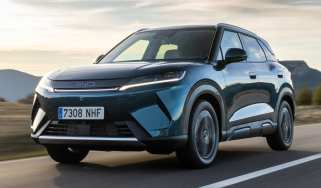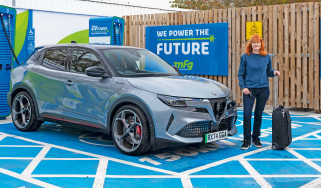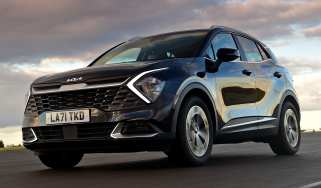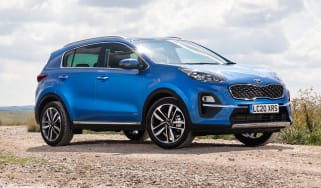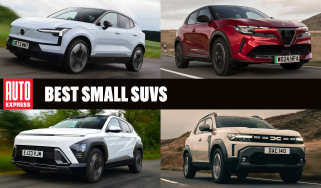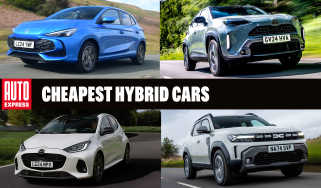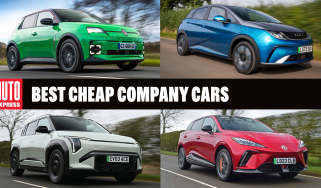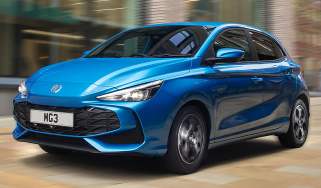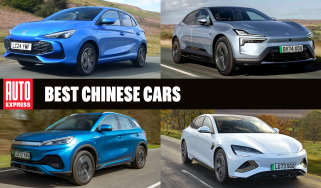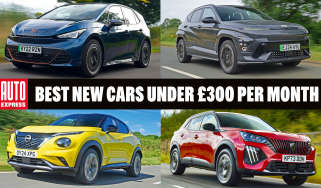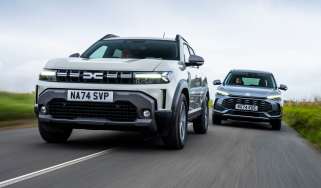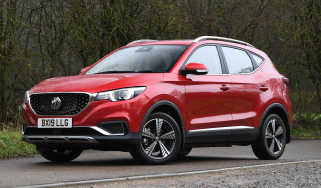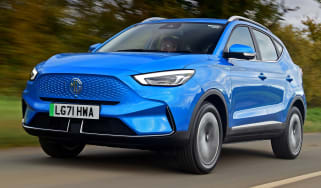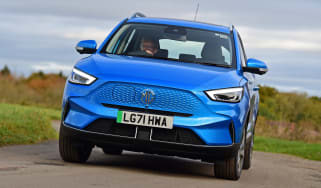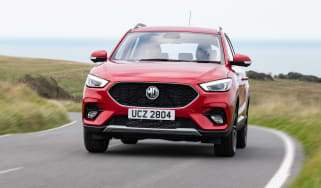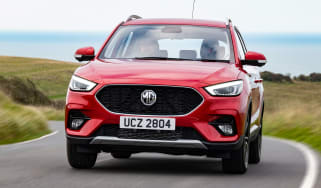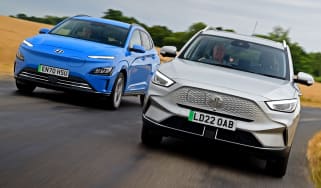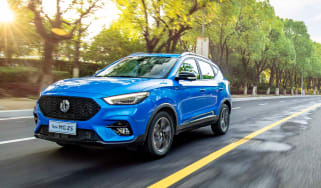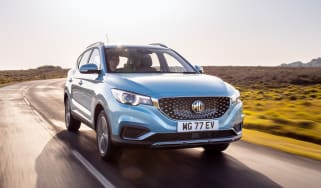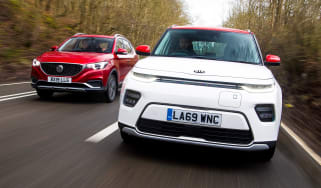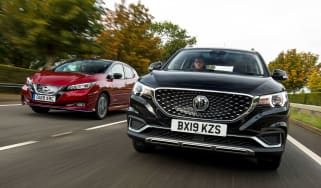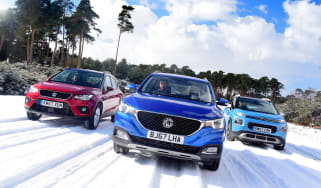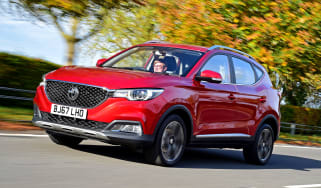MG ZS review
As one of the cheapest brand-new SUVs you can buy, the ZS is a pretty convincing bargain

Our opinion on the MG ZS
MG is going from strength to strength in the UK, with new models appearing left, right and centre, including this latest ZS. From the humble MG3 hybrid supermini to the head-turning Cyberster sports car, the brand is attacking the automotive establishment from all angles – and usually with strong results when put through our tests.
That bodes well for the ZS, whose closest rival is the Dacia Duster when it comes to price and powertrain. However, that’s not the only competition that this model must overcome; buyers can’t get enough of the Ford Puma, and it’s easy to see why when it drives so brilliantly. Other popular choices in the segment include the Nissan Juke and one of our class favourites, the Renault Captur, both of which are also offered with hybrid power.
| Key specs | |
| Fuel type | Petrol, hybrid |
| Body style | Five-door compact SUV |
| Powertrain |
1.5-litre 4cyl petrol 1.5-litre 4cyl petrol-electric hybrid |
| Safety | 4-star Euro NCAP (2024) |
| Warranty | Seven years/80,000 miles |
About the MG ZS
The second-generation MG ZS has jettisoned its electric powertrain completely, with the MGS5 EV taking on small electric SUV duties instead. Now, the ZS is only available with petrol or full-hybrid power. This latter suits this car particularly well and sets it apart from a number of competitors, in what is fast becoming a vastly overcrowded market.
While the ZS is good enough to drive, spacious and economical, the real selling point is its low list price, which allows it to undercut rivals by several thousand pounds. Even on a monthly finance deal, MG claims it’s over £100 less than a like-for-like Hyundai Kona. That alone is almost certainly contributing towards this SUV becoming an increasingly common sight on Britain’s roads.
Used - available now
Thankfully, the arrival of hybrid drive hasn’t caused prices to shoot up, with the entry-level ZS hybrid weighing in at around £22,000. That’s already cheap in small SUV terms, but the petrol model trims yet another £2,000 off this figure. This means that the only brand-new SUV that’s available for less is the Dacia Duster. The ZS also undercuts the top-selling Ford Puma and Hyundai Kona by around £6,500.
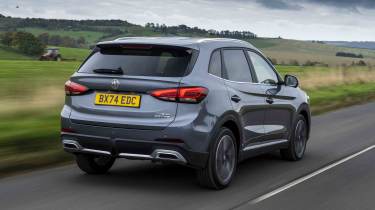
Regardless of its notably low starting price, the ZS is still well equipped in base SE trim. Standard kit includes a 12.3-inch touchscreen with built-in sat-nav, plus Apple CarPlay and Android Auto, as well as a reversing camera and a suite of MG Pilot safety systems.
The top-spec Trophy model is around £2,500 extra, but this adds luxuries such as heated leather-style seats, a heated steering wheel, rear privacy glass and a 360-degree parking camera. We think it’s worth spending a little extra per month for the Trophy’s additional kit.
The MG ZS is one of the UK’s cheapest SUVs, but if you want to find the very best deals that’s where our Find a Car service comes in. You can configure your ideal MG ZS and see the best prices from nearby dealerships, take a look at the best ZS leasing deals or choose from plenty of used ZS models. Got a car you need to sell first? Our Sell My Car service can help you with that, too.
MG ZS prices and latest deals
How much does the MG ZS cost? Well, official ‘on the road’ prices range from £19,975 to £25,015 but you can currently save an average of £4,262 through the Auto Express Find A Car service, where prices start at £16,770. You can lease a MG ZS from £224 per month or buy a used model at prices starting from £18,350.
Check out our latest new car deals, leasing deals and used car deals for the top offers available now on Auto Express. And don't forget we can help you sell your car, too.
Performance & driving experience
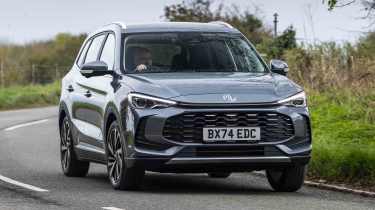
Pros |
Cons |
|
|
At launch, only a hybrid powertrain was available in the ZS, but MG has since added a pure petrol engine to the mix. The hybrid set-up is shared with the smaller MG3 hatchback, which means the petrol engine can drive the wheels directly if necessary, but for the most part, it acts as a generator, sending energy to charge the 1.83kWh battery, which powers the electric motor.
As with the MG3, the ZS Hybrid+ relies on the electric motor more than the petrol engine. On its own, the little e-motor makes 134bhp and 250Nm – a figure that beats the combined hybrid system output of many of its rivals. That’s backed up by a 1.5-litre four-cylinder petrol engine, which helps out with another 101bhp and 128Nm. All in, the combined system output is 193bhp and a hefty 343Nm of torque.
On paper, a three-speed automatic gearbox sounds like a throwback to MGs of the ‘70s, but it’s all that is really needed as a result of that electric motor. The engine itself is a development of the 1.5-litre petrol used in earlier MG models; while we’ve found it pretty unpleasant in the past, here it’s very much taking a back seat, and as a result, it’s easier to live with.
The cheaper petrol model is also powered by a 1.5-litre engine, but there’s no electrical assistance to be found here. Under its own steam, this four-cylinder engine produces 113bhp and 148Nm of torque. If you prefer automatic cars, you’ll have to go for the hybrid because the petrol is only available with a six-speed manual.
The MG ZS’s ride and handling are above average for the segment, but there are one or two areas which let it down ever so slightly. These are somewhat forgivable when considering the starting price, though, and in most day-to-day scenarios, the ZS is a perfectly acceptable family ferry.
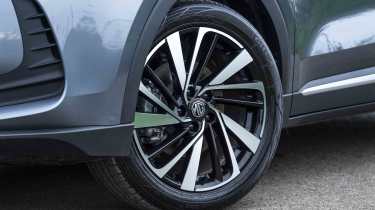
Performance, 0-60mph acceleration and top speed
The larger body of the ZS Hybrid+ means that it doesn’t quite deliver the same brilliant performance as the MG3 supermini, which uses the same powertrain. However, a 0-62mph time of 8.7 seconds is still a strong return and likely to be more than enough for most drivers. There’s a top speed of 104mph, too.
Cutting out electric power does result in a significant power reduction, though, as the petrol model takes a lethargic 12.5 seconds to reach 62mph from a standstill. When you eventually get there, this model’s top speed is slightly higher at 111mph. While we’re doubtful that ZS drivers are intending to floor their right foot at every opportune moment, the hybrid is still the superior performer for getting up to motorway speeds.
Town driving, visibility and parking
With its electric motor generating significantly more power than other hybrids, the MG ZS feels more like an EV around town. From 0-30mph, performance is genuinely excellent, with a keen yet smooth power delivery that makes it a great car for nipping through city traffic.
We haven't driven the petrol model yet, but the figures on paper aren’t making us optimistic about reaching our destination as quickly as we would in the hybrid.
At 10.5 metres, the ZS’s turning circle is quite tight, which means that backing into spaces and squeezing through small gaps is fairly easy. The ride is a little busier than it is in the Dacia Duster, but not as firm as the Ford Puma.
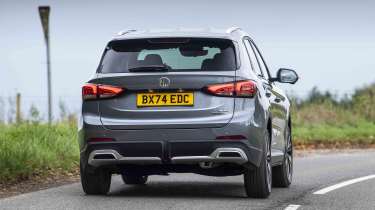
B-road driving and handling
At higher speeds, the hybrid’s power delivery throws up some quirks. Ask for more performance than the electric motors can offer – for example when accelerating along a motorway slip road – and while the acceleration never lets up, there’s a long wait as the petrol engine wakes, selects the right gear ratio and eventually gives you its all.
When it does, it’s very quick, but the end result isn’t very linear. Drawn as a graph, the acceleration would look like a two-humped camel as opposed to the gentle, consistent curve that most cars deliver.
The engine still sounds a little rough when you’re making it work hard, but most of the time it’s reasonably muted because that electric motor is strong enough to do the majority of the heavy lifting.
The ZS is more than capable enough when you’re negotiating a twisty B-road. It won’t elicit a smile in the way a Ford Puma will – it all feels a bit too numb to be called fun to drive – but the MG’s body is reasonably well controlled, and a decent ride quality is maintained throughout.
The steering is precise enough, but the weighting can feel a little unnatural beside some rivals. While not outstanding in any one area, the MG ZS is certainly more sophisticated to drive than its predecessor.
Motorway driving and long-distance comfort
One area in which the ZS doesn’t quite feel so honed is the road noise at the legal limit. Tyre roar is quite audible, which means that it isn’t quite as refined as you’d hope on longer journeys. Some testers found that the driver’s seat isn’t the most comfortable either, due to a headrest that protrudes too far from the backrest.
| Model | Power | 0-62mph | Top speed |
| ZS Petrol | 113bhp | 12.5 seconds | 111mph |
| ZS Hybrid+ | 193bhp | 8.7 seconds | 104mph |
Expert view, on driving experience
“MG is known for its sports cars, and the ZS hybrid is also reasonably spritely when you put your foot down. The hybrid electric motors help for a nice quick getaway from traffic lights, and while the petrol engine can be reluctant to kick in, you get a decent bit of extra shove when it does.” - Shane Wilkinson, senior content editor, who tested the MG ZS on the Auto Express Youtube channel.
MPG & running costs
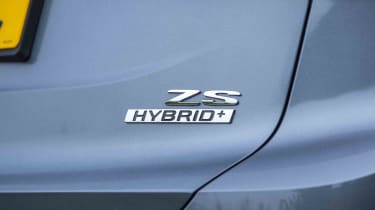
Pros |
Cons |
|
|
Based on official WLTP figures, the MG ZS Hybrid+ is capable of 55.4mpg. In the real world, that figure doesn’t seem like an impossible task, with our fairly typical use across a variety of roads throwing up a reasonable figure of 48.7mpg.
The petrol model doesn’t perform too badly in isolation with its claimed combined figure of 43.5mpg, but we’ll have to wait until we’ve put this version through its paces to see if it can come close to this in real-world driving. Regardless of that outcome, though, the hybrid is the way to go for the lowest fuel bills.
Company car drivers seeking Benefit-in-Kind tax savings might actually wish to avoid the ZS altogether, because it simply cannot match the low rates offered by electric cars. MG does offer an alternative, though, in the form of the MGS5 EV.
| Model | MPG | CO2 | Insurance group |
| ZS Petrol | 43.5mpg | 146g/km | 16 |
| ZS Hybrid+ | 55.4mpg | 115g/km | 22 |
Insurance groups
The latest MG ZS sits in a slightly higher insurance group than its predecessor, potentially due to the fact that its older incarnation (ignoring the all-electric version) was petrol only, whereas the latest car also offers a more powerful and complex hybrid system.
Both the SE and Trophy trims are in group 22, which is a little lower than the hybrid version of the Dacia Duster in group 24.
It’s here where the petrol car has an advantage because it sits in group 16, although this is the same as the hybrid-powered Renault Captur E-Tech.
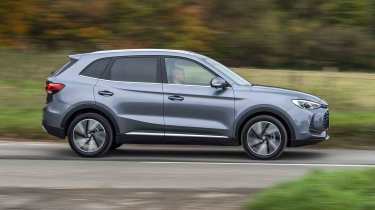
Tax
Every MG ZS attracts the standard rate of VED road tax from the second year onwards. Low pricing also means that the £40,000 luxury car threshold for road tax is avoided, too.
Depreciation
The MG ZS is predicted to hold on to between roughly 52 and 54 per cent of its value (the stronger residuals are for the cheaper SE model) after three years. That’s largely similar to the forecasted results for the Renault Captur and better than the Ford Puma, both of which are more expensive to buy in the first place. However, all versions of the Duster have stronger residuals than every one of these rivals.
To get an accurate valuation for a specific model, check out our free car valuation tool...
Interior, design & technology
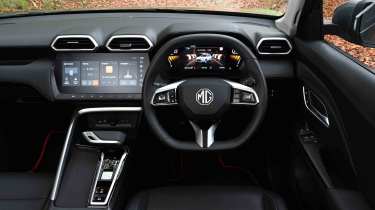
Pros |
Cons |
|
|
MG has tried to make the interior of the ZS feel premium, but there are one or two telltale signs that it isn’t as well put together as some other rivals.
Interior and dashboard design
Up front, the cabin looks fairly smart. There’s even some inspiration that seems to be borrowed from the most exotic of places; those individual air vents sitting at the top of the dashboard have more than a hint of Lamborghini Huracan about them.
That’s as far as the Italian supercar comparisons go, however, because the remainder of the cabin appears conventional in an inoffensive way. Beneath the large, 12.3-inch central touchscreen sits a row of physical keys, but these don’t include a full set of climate controls; with the exception of buttons for the front and rear heated windows, the rest of the functions must be adjusted on the touchscreen itself.
The steering wheel is slightly flattened on both its upper and lower edges and feels great to hold, while the gear selector takes the form of a wide, flat lever that’s reminiscent of the throttle on a large aircraft. Ahead of it is a space to hold a smartphone, and the glovebox is generously sized.
Parts of the cabin design don’t feel all that well thought out. The silver trim on the leading edge of the centre console and steering wheel can be distractingly reflective, and on one occasion, we caught our finger between the gearlever and the recess it sits within when selecting reverse. Be assured, though, you’re only likely to do this once given how much it hurts.
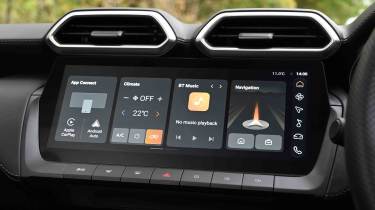
Materials and build quality
At first glance, the ZS’s cabin has a slightly premium feel to it, with leather-effect stitching and soft plastics covering the top of the dashboard. However, it doesn’t take long to discover that the impression is created by a fairly thin coating on top of a budget car.
The lid for the centre armrest feels as though it’s barely held in place, and the hinge is loose and somewhat floppy. One of our test cars also had a glovebox that didn’t fit properly, while the fake leather upholstery doesn’t feel very convincing.
Infotainment, sat-nav and stereo
All versions of the ZS come with a digital driver’s display as standard. A portion of the display shows a digital image of the car in graphics reminiscent of a PlayStation 3 driving game, but it also presents a wealth of information, including speed, efficiency, the drive mode you’re in, and other trip details. Unusually for a hybrid, there’s even a rev counter.
While some rival models feature physical climate controls, the ZS is immediately limited by a system that forces the driver to make adjustments to the heat and fan speed using the 12.3-inch touchscreen. This forces you away from whatever page was previously loaded just to achieve a comfortable temperature, which is particularly irritating if the page in question is a map screen that’s being used for navigation.
It’s a shame, because the screen has a high resolution (as does the feed from the parking cameras) and the layout is neat and logical. The Apple CarPlay and Android Auto smartphone connections are both wired rather than wireless, but the hook-up is easy and it fills the whole screen – a positive and a negative, because you’ll need to hit the home button on the physical shortcut control bar to access things such as the climate control.
Expert view, on design
“If you want to add another £695 to the mix you’ll get the rather lovely Dynamic Red paint which gives a certain fashionable quality to the fairly subdued styling. The ZS certainly isn’t ugly, but it doesn't do anything to stand out from the crowd, either.” - Shane Wilkinson, who drove the MG ZS Hybrid+ for an Auto Express video review.
Boot space & practicality
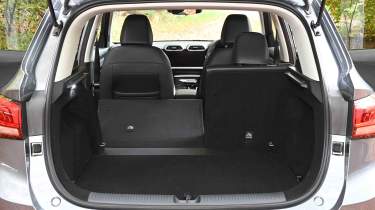
Pros |
Cons |
|
|
While it’s not the class leader in terms of practicality and interior space, the MG ZS still offers plenty of room for a family of five. In fact, it’s one of the most spacious cars for this sort of price, which will ultimately be good news for families who need to carefully watch the pennies.
| Dimensions | |
| Length | 4,430mm |
| Width | 1,818mm |
| Height | 1,635mm |
| Number of seats | Five |
| Boot space | 443-1,457 litres |
Dimensions and size
The MG ZS is roughly the same size as a Dacia Duster or Nissan Qashqai, while the high driving position helps with positioning the car on the road. At 1.8 metres wide, there shouldn’t be any issues when it comes to dealing with width restrictions.
Driving position, seats & space in the front
Perhaps more than any other area, the one thing that betrays the sense of cost-cutting in the MG’s cabin is the lack of reach adjustment for the steering wheel. Aside from the most basic of city cars (plus, as it turns out, the MG3 supermini), almost every mainstream family car on sale today now has this feature, so it’s pretty poor to find it lacking here.
It’ll really limit the level of comfort that some drivers are able to find; while a few will appreciate the huge distance that the driver’s seat can slide back and forth, for other drivers it’s harder to feel truly comfortable here than in any of its rivals. The driver’s seat will also seem a little too high for some taller drivers.
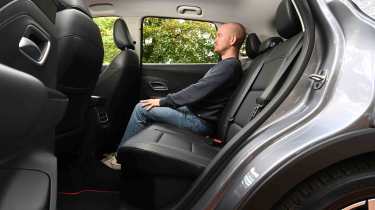
Seats & space in the back
Knee room is certainly a strong suit for the MG ZS, with plenty of space for tall adults to stretch out in the back. Combined with plentiful foot space beneath the front seats and above-average headroom for a car of this type, it’s a spacious place to be. Rear ISOFIX points are a little buried between the upper and lower seat cushions, so they’re not as easy to access as in some alternatives, but they are better than the Duster’s zipped points.
Boot space
At 443 litres, the MG ZS’s boot volume is reasonable, if not outstanding, for a car in this class. The load area has a fairly low lip and minimal wheel arch intrusion, so it’s easy to make the most of the volume on offer, while some items can be hidden below the false floor. The seats drop almost flat to increase the overall volume to 1,457 litres. Once again, this isn’t a class-leading figure; for example, the Dacia Duster Hybrid offers 1,545 litres in the same two-seat configuration.
Towing
If you have a trailer or caravan to hook up, you may find yourself in a bit of bother because both powertrains are only rated to tow a braked trailer of up to 500kg. This figure is comparatively tiny compared to the Nissan Qashqai’s 1,400kg limit.
Expert view, on practicality
“There’s 443 litres of boot space, which isn’t too bad, but the ZS is over 100 litres down on the Dacia Duster. However, the MG is a lot lower when it comes to loading, so you’re not going to hurt your back as easily.” - Shane Wilkinson, senior content editor, who tested the MG ZS on our Youtube channel.
Reliability & safety
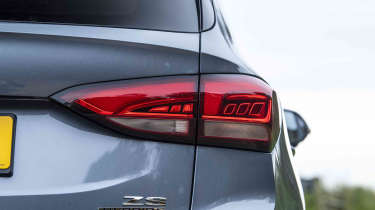
Pros |
Cons |
|
|
There’s an element of ‘buyer beware’ when choosing an MG, based on the opinions of owners who answered our latest Driver Power survey, because the brand finished 32nd out of 32 manufacturers when it comes to customer satisfaction. There were very few reasons for owners to stay loyal, and with more than 28 per cent of owners experiencing a fault of some sort within the first year of ownership, only four manufacturers in the survey proved to be more unreliable.
As with a number of its small SUV rivals, the MG ZS fell short of a five-star rating from Euro NCAP. Like the Renault Captur, the ZS received four stars when it was tested in 2024, because the safety body wasn’t satisfied that the car would be able to deliver the same level of protection to occupants of differing sizes in all seating positions. The ZS also fails to prevent front-seat occupants from hitting each other in a side impact.
| Key standard safety features | Euro NCAP safety ratings |
|
|
Buying and owning
- Best buy: MG ZS Hybrid+ Trophy
The MG ZS’s price is so reasonable that the range-topping model is still very cost-effective. Trophy trim adds some useful goodies to the ZS, making it feel like a slightly more premium affair.
The hybrid powertrain is by far the best choice thanks to its genuinely strong performance and real-world efficiency.
Alternatives
There are numerous options in the small SUV segment, with models offered by nearly every mainstream car maker that cater to a wide range of needs.
One of the big hitters is the Ford Puma, which is a consistently strong seller, and for good reason. It’s the best car in this class to drive, and while the engine range is limited, Ford’s petrol EcoBoost units suit the car well. Practical features such as the hidden Megabox in the boot mean it’s well suited to family life, too.
Another favourite small SUV of ours is the Renault Captur. Again, clever features such as the sliding rear bench make it a great choice for those with kids, while the option of various hybrid powertrains allows you to keep running costs in check.
Other options include the Toyota Yaris Cross and Nissan Juke – the latter of which is built in the UK and sells in huge numbers. Cars such as the Vauxhall Mokka, Peugeot 2008 and Hyundai Kona offer plenty of powertrain choices, including zero-emission electric options, if they’re of interest.
Latest deals on the ZS and rivals
MG ZS pictures
New & used MG ZS deals






